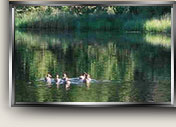The most avid
and knowledgeable fisherman on the ranch reports, "I walk the river all the
time. I see fish significantly over two pounds in the
river all year except in July and August when the river warms up.
In July and August, I only see fish in the
4-7 inch range. It seems one can only catch large fish
when the water is cooler. I did catch a four pound brown trout
in my back yard at the very end of May 2007." In 2008, the
river was open for trout fishing from May 24 through October 31.
The local fish biologist with the Oregon
Department of Fish and Wildlife (ODFW) advises there are a few large
brown trout in the river on the ranch but virtually no small ones.
When the river drops in October there are very few pockets of slow
water and insufficient cover for the fish population. The big fish
eat the small fish. He says there are no rainbow trout because the
rainbows require more gravel to spawn than do the browns and there
isn’t enough for them.
In 1990 or 1991 ODFW collected and reported
habitat and electrofishing data for the river within the ranch. The
ranch has the cover letter, dated February 8, 1991, but the actual
data and report are no longer available.
Habitat
In the 2005 ODFW fish habitat assessment as
part of the final report on the OWEB bank stabilization project,
ODFW reports that early land clearing (presumably by the Vandeverts)
destabilized the stream. Channel simplification decreased the
stream complexity. Stream complexity (i.e. the variety of
environments within the river) is beneficial for fish. Cattle
grazing, of course, prevented recovery of the eroded banks.
Gradually sloped banks do not provide good fish habitat and
continuing erosion provides sediment that fills the spaces in the
gravel and reduces spawning success.
ODFW has advised the river is Stream Type “E”
within the Rosgen Classification System (http://www.fgmorph.com/fg_6_37.php).
An E type stream meanders through broad valleys and meadows with
well vegetated streambanks. It has a low gradient and a low
width/depth ratio (it is relatively narrow for its depth). The
authors will investigate this classification further because it
seems to fit the Little Deschutes except for the low width/depth
ration. In fact the river appears to be relatively shallow for its
width.
Factors Limiting Trout Population
The factors that may be limiting the trout
population are described below in order of most likely to least
likely, in the judgment of the authors. There are still many
unknowns. The relative importance of the different factors is
subject to debate and can only be better understood through further
investigation.
1.
Shortage of dissolved oxygen – From the mouth of the Little
Deschutes up to approximately its junction with Crescent Creek, the
river is listed with the EPA for low levels of dissolved oxygen.
The shortage of oxygen limits the number and size of trout the river
can support. It limits the energy trout can expend getting food and
slows their growth.
2.
Shortage of undercut banks – Undercut banks, where the bank
projects out over the river, are good environments for trout because
they generally have slower water, the water is often out of the
direct sunlight, and the bank provides some protection from
predators. The river may gradually develop more undercut banks as
it recovers from historical grazing. The OWEB stream restoration
projects will accelerate this process and the submerged trees will
help substitute for undercut banks in the meantime. The extent of
undercut banks may be naturally limited on the ranch by the
pervasiveness of sandy soils that readily slump. Fortunately
sloping banks are good environments for willows that hold the earth
and slow erosion.
3.
High water temperature – This stretch of the river is not
listed by the EPA for high water temperature but, for much of the
summer, the water temperature is higher than the 57 degrees to 62
degrees Fahrenheit that is ideal for trout. The most
knowledgeable fisherman on the ranch believes water temperature is
the primary reason there are not more big fish to be had during
fishing season. High water temperature
contributes to lowering the levels of dissolved oxygen. Further
investigation needs to be done on what the water temperature is by
season, location along the river, and depth.
4.
Lack of good spawning environment – Trout ideally spawn where
the river bottom is clean gravel or gravel mixed with cobbles. The
gravel provides crevasses that the eggs lodge in while being
supplied with fresh oxygen. The newly hatched trout (the
fry) can find food in the gravel while not being swept away by the current.
There is very little gravel or cobble in the river here although
gravel is plentiful in some other stretches of the river (e.g. the
south end of Deschutes County). To the extent there may be gravel,
the river bottom on the ranch is “impacted” by fine sediments that
fill up the crevasses between the rocks and gravel and make the
river bottom a less productive hatchery. Because the flow of the
river is controlled at Crescent Lake Dam, the peak flow during the
year is not as high as it would be naturally and is not as effective
at washing out the sediments. Brown trout are better able to spawn
in somewhat impacted spawning environments than are rainbows.
With the approval of
ODFW, and probably of the Department of State Lands and the Army
Corp of Engineers, the ranch could place gravel and rock in the
river. This was done on Spring River for spawning rainbow and may
have been done at Crosswater as well.
5.
Inadequate places for fish to rest – The ideal spot for
a fish is a seam where fast water and slow water are right next to
each other. The faster water brings more food past the fish
while the slower water gives the fish a place to rest.
Conventional wisdom suggests the ideal trout stream will consist of
50% pools (slow water) and 50% riffles (fast, turbulent water).
Many successful trout streams depart from this ratio. In the ODFW letter of
February 8, 1991, the fish habitat biologist reports that pools
(slow water) make up only 9% of the length of the river while glides
(non-turbulent faster water flowing smoothly) make up 91%. Riffles are virtually non-existent.
Direct observation qualifies
ODFW's findings somewhat. While the main flow never pauses to
form a lake-like pool, there are many good-sized pockets of slow
water along the twists and turns of the riverbanks. Depth
measurements show an average river depth of about four feet with
many eight-foot deep holes where the deeper water must flow more
slowly.
Any shortage of slow water would be particularly
important in the winter when trout metabolism slows down, the fish eat
far less, and they prefer to spend almost all their time in slow
water. The low stream flows in the winter mean the pools are not as
big or as deep. Trout are territorial and competitive. The bigger
and stronger trout eat many of the younger and smaller trout and
drive others downstream. Eliminating the younger fish in the winter
yields a smaller fish population in the spring and summer.
The OWEB-sponsored
stream restoration projects increase slow water along the banks and,
by directing more flow to the center of the stream, dig deeper pools
in the center of the river. Placing more woody debris in the river,
not always up against the banks, would increase stream complexity
with more areas of slow water and some areas with water running
faster than
the general flow of the river.
Definitions:
Glide – An area of
smoothly flowing water with moderately low velocity (10 to 20 cm.
per second) and little or no surface turbulence.
Pool – Part of a
stream slower than the main flow, often with deeper water than the
surrounding area.
Riffle – An area
where water flows swiftly over completely or partially submerged
obstructions creating surface turbulence.
6.
Lack of food – Trout primarily eat larval
insects and very small aquatic animals that grow best in riffles
where they get more oxygen and have cleaner rocks to cling to and
hide under. The lack of riffles undoubtedly limits food
production in the stream but the lack of dissolved oxygen that
riffles would produce appears to be a far more important factor in
limiting the summer trout population.
There are no significant
pollutants in the water. The mosquito abatement program is mosquito
specific and environmentally conscientious.
7.
Shelter from predators – Osprey and otters are the primary fish
predators in the area. The shortage of deep pools in the river give
the otter something of an advantage. But the fish are faster and
there is no reason to think otter predation is any greater here than in
other rivers where trout are thriving. Fish in midstream are
clearly visible to osprey but willows provide good cover along most
of the banks and are growing thicker every year.
8.
Unseasonable stream flows – Aside from the effects on the
temperature and the spawning environment described above, there is
no reason to believe the higher than natural flows in the summer and
lower than natural flows the rest of the year have a direct effect
on the trout.
9.
Pollution – Except for low levels of dissolved oxygen, the river is
not listed by the EPA for any pollutants and there is no other
evidence that the river is polluted.
Good sources of additional information include
the following:
Hunter, Christopher J., Better Trout
Habitat: a guide to stream restoration and management, Island
Press, Covelo, CA
Izaak Walton League of America, A Handbook
for Stream Enhancement and Stewardship, The McDonald and
Woodward Publishing Company, Blacksburg, VA
Continue to Government Impact
Return to
Stewardship Plan Table of Contents






